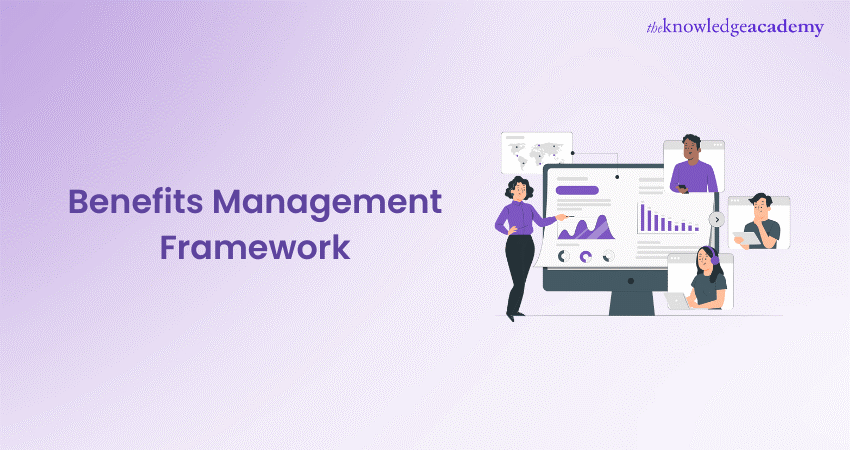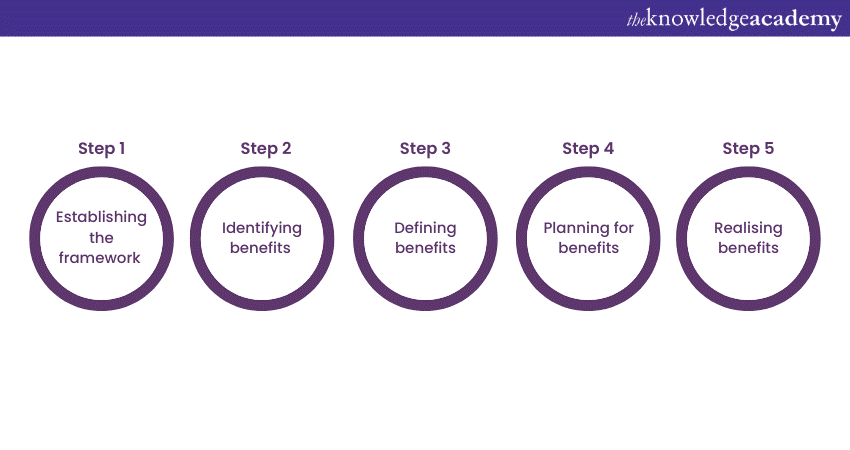We may not have the course you’re looking for. If you enquire or give us a call on 01344203999 and speak to our training experts, we may still be able to help with your training requirements.
Training Outcomes Within Your Budget!
We ensure quality, budget-alignment, and timely delivery by our expert instructors.

The modern-day organisation strives to achieve maximum value from its investments and initiatives. Many organisations achieve this by implementing a Benefits Management Framework, which helps them identify, define, plan, and realise the Benefits of their projects and programs. Discover how a Benefits Management Framework can help you achieve your project goals, optimise your investment, and align your actions with your vision. Read our blog to learn more about this systematic and effective method.
Table of Contents
1) What is a Benefits Management Framework?
2) Key components of a Benefits Management Framework
3) Steps of the Benefits Management Framework process
4) Benefits Management Framework best practices
5) Conclusion
What is a Benefits Management Framework?
A Benefits Management Framework systematically plans, manages, and measures the Benefits an organisation expects to achieve from its projects and programs. It helps ensure that the Benefits are clearly defined, aligned with the strategic objectives, and tracked throughout their lifecycle. This framework provides guidance, processes, tools, and templates supporting Benefits Management activities.
This can help organisations improve their performance and increase their Return on Investment (ROI) by:
a) Focusing on the outcomes and Benefits rather than the outputs and deliverables
b) Prioritising and selecting the projects and programs that contribute the most value to the organisation
c) Engaging and communicating with the stakeholders and Beneficiaries of the Benefits
d) Managing the changes and risks that may affect the Benefits realisation
e) Monitoring and evaluating the Benefits and adjusting the plans as needed
f) Capturing and sharing the lessons learned and best practices
One example of a Benefits Management Framework is the one developed by Method Grid, which is part of their Project and Program Management Methodology (PPM) grid. This framework is based on internationally recognised standards and best practices, such as Prince2 and Managing Successful Programmes (MSP). It provides a flexible and comprehensive set of tools and templates that can be customised and adapted to suit different organisations' and delivery teams' needs and preferences.

Key components of a Benefits Management Framework
This framework consists of the following key components:
a) Benefits identification: The first step in the framework is to identify the potential Benefits associated with the project. This involves conducting thorough research, engaging stakeholders, and gathering data to determine the expected outcomes.
b) Benefits definition: Once the Benefits are identified, they need to be clearly defined. This step involves describing each Benefit in detail, including its scope, metrics for measurement, and alignment with organisational objectives.
c) Benefits planning: Organisations develop strategies and action plans in the Benefits planning phase to ensure the realisation of identified Benefits. This includes allocating resources, establishing timelines, and determining the responsibilities of key stakeholders.
d) Benefits realisation: The Benefits Management Framework's final stage is realising the identified Benefits. This involves implementing the planned actions, monitoring progress, and assessing the actual outcomes against the expected benefits.
Want to boost ROI through effective Benefits Management? Try our comprehensive Managing Benefits Foundation and Practitioner Course today.
Steps of the Benefits Management Framework process

The Benefits Management Framework follows a structured process to ensure the successful management of Benefits. The process typically includes the following steps:
Step 1: Establish the framework
Before initiating any project, it is essential to establish a clear and well-defined framework. This step involves creating a governance structure, defining roles and responsibilities, and establishing communication channels.
Step 2: Identify the Benefits
In this step, organisations identify the potential Benefits associated with the project. This includes conducting feasibility studies, analysing data, and engaging stakeholders to determine the desired outcomes.
Step 3: Define the Benefits
Once the Benefits are identified, they need to be precisely defined. This involves describing each Benefit, setting measurable targets, and aligning them with the organisation's strategic goals.
Step 4: Plan for Benefits
The next step is to develop a comprehensive plan for realising the identified Benefits. This includes defining the necessary actions, allocating resources, establishing key performance indicators (KPIs), and creating a timeline for implementation.
Step 5: Realise the Benefits
The final step is the implementation of the planned actions to realise the identified Benefits. It involves closely monitoring the progress, making necessary adjustments, and evaluating the outcomes against the defined targets.
Elevate your Benefits Management skills to the next level with our Managing Benefits Training. Sign up now!
Benefits Management Framework best practices
To ensure the effective implementation of a Benefits Management Framework, organisations should consider the following best practices:
a) Clearly define objectives and Benefits: Understanding the project's objectives and associated Benefits is crucial. Clearly defining these helps align the project activities and ensures the desired outcomes are achieved.
b) Engage stakeholders: Engaging stakeholders throughout the Benefits Management process is essential. Organisations can gather valuable insights, address concerns, and ensure their support for the successful realisation of Benefits by involving key stakeholders.
c) Monitor and track Benefits: Monitoring and tracking Benefits are crucial to ensure their successful realisation. Organisations should establish robust mechanisms to collect data, measure progress, and identify any deviations from the planned outcomes.
d) Adapt and improve the framework: The framework should adapt to changing circumstances. Regularly reviewing and improving the framework based on lessons learned and stakeholder feedback enhances its effectiveness.
Conclusion
A Benefits Management Framework provides a structured approach for organisations to manage and maximise the Benefits associated with their projects, programs, and portfolios. Integrating this framework into organisational practices contributes to long-term success, enabling organisations to achieve their strategic objectives and deliver value to stakeholders.
Enhance your strategic capabilities with our comprehensive Managing Benefits Training Courses. Join today for long-term success!
Frequently Asked Questions

This framework fosters accountability and efficiency by:
a) Clarifying the expected Benefits and aligning them with the strategic objectives
b) Assigning clear roles and responsibilities for the Benefit owners and stakeholders
c) Establishing a robust process for measuring and reporting the Benefits
d) Enabling continuous improvement and learning from the Benefits realisation

This framework can adapt to changing market dynamics and project requirements by:
a) Conducting regular reviews and evaluations of the Benefits and their assumptions
b) Identifying and managing the risks and issues that may affect the Benefits realisation
c) Adjusting the Benefits plans and targets as needed
d) Communicating and engaging with the stakeholders and Beneficiaries about the changes

The Knowledge Academy takes global learning to new heights, offering over 30,000 online courses across 490+ locations in 220 countries. This expansive reach ensures accessibility and convenience for learners worldwide.
Alongside our diverse Online Course Catalogue, encompassing 17 major categories, we go the extra mile by providing a plethora of free educational Online Resources like News updates, Blogs, videos, webinars, and interview questions. Tailoring learning experiences further, professionals can maximise value with customisable Course Bundles of TKA.

The Knowledge Academy’s Knowledge Pass, a prepaid voucher, adds another layer of flexibility, allowing course bookings over a 12-month period. Join us on a journey where education knows no bounds.

Discover Managing Benefits courses with The Knowledge Academy, offering Managing Benefits Foundation and Practitioner courses. Designed for diverse skill levels, these courses provide a comprehensive understanding of Benefits Management methodologies.
Whether you are starting your journey or aiming to elevate your Benefits Management expertise, immerse yourself in our Benefits Management blogs to discover more insights!
Upcoming Business Skills Resources Batches & Dates
Date
 Managing Benefits™ Foundation
Managing Benefits™ Foundation
Mon 3rd Feb 2025
Mon 14th Apr 2025
Mon 16th Jun 2025
Mon 11th Aug 2025
Mon 6th Oct 2025
Mon 1st Dec 2025







 Top Rated Course
Top Rated Course


 If you wish to make any changes to your course, please
If you wish to make any changes to your course, please


